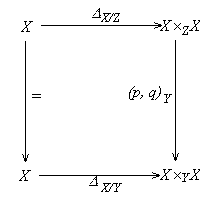|
In this section we assume C is a metric site with finite limits. Let Z be a final object of C. Definition 5.3.1. A morphism f: X ® S is called separated if the diagonal morphism D = (1X, 1X)S: X ® X ×S X is a universally closed morphism. If f is separated we also say that X is separated over S. An object X is called separated if it is separated over the final object Z. Proposition 5.3.2. Suppose f: X ®
S is a morphism. The following conditions are equivalent:
Proof. By (5.2.8). Corollary 5.3.3. Suppose C
is a site such that any special morphism is bicontinuous. Suppose f:
X ® S is a morphism. Then the following
conditions are equivalent:
Proof. By (5.2.6). Proposition 5.3.4. (a) Any monomorphism
is separated.
Proof. (a) Suppose f: X ®
S is a monomorphism. Then X = X ×S
X (4.2.6.h). Thus |D(X)|
= |X ×S X| is a closed subset of
|X ×S X| and f is separated.
 (d). We have XS' × YS' XS' = (X ×Y X) ×Y YS' and DXS' = DX ×Y 1YS'. Then apply (5.2.7.c). (e) is equivalent to (d) by (5.1.11). (f) By (5.1.12) in view of (a) and (e). Corollary 5.3.5. Let f: X ® S be a separated morphism. Suppose U Í |X| and V Í |S| are effective subsets and f(U) Í V. Then U is separated over V. Proof. The composite g: U ® S of the effective morphism U ® X and the separated morphism f: X ® S is separated (5.3.4.c). Let h: U ® V be the induced morphism and i: V ® S the inclusion. Then g = ih is separated implies that h is separated (5.3.4.f). Corollary 5.3.6. (a) An object X
is separated if and only for any object S, any morphism f: X ®
S is separated.
Proof. (a) The condition is sufficient because we may take f
to be the canonical morphism from X to the final object Z.
For the necessity let i: X ®
Z and j: S ® Z
be the natural morphisms to the final object Z. Then we have i
= jf. Thus f is separated if i is so by (5.3.4.f).
Corollary 5.3.7. Suppose X is a separated. Then any effective subobject of X is a separated object. Definition 5.3.8. Suppose f: X ® S is a morphism. A diagonal cover of X over S is an effective open cover {Ui} of |X| such that {|Ui ×S Ui|} is an open cover of |X ×S X|. Remark 5.3.9. An effective open cover
{Ui} is a diagonal cover if any of the following conditions
are satisfied.
Proposition 5.3.10. Suppose {Ui} is a diagonal cover of X such that each Ui is separated over S. Then f is separated. Proof. Suppose each Ui is separated over S. Then Ui = DX-1(Ui ×S Ui) ® Ui ×S Ui is a universally closed morphism. Since {|Ui ×S Ui|} is an open cover of |X ×S X|, Df is a universally closed morphism by (5.2.7.e). Thus f is separated. Proposition 5.3.11. Suppose C is a site such that the topology t: C ® Top preserves finite limits. An object X is separated if and only if the underlying space of X is Hausdorff. Proof. An object X in such a site C is separated if and only if the space of X is separated in the site Top. Thus it suffices to prove the assertion for Top. First we assume X is a Hausdorff topological space. For any (x, y) Î X × Y and (x, y) Ï D(X), we have x ¹ y, therefore we can find two neighborhoods U and V of x and y respectively such that U Ç V = Æ. Then W = p-1(U) Ç q-1(V) = U × V is a neighborhood of (x, y) and W Ç D(X) = Æ. This means that D(X) is closed, hence X is separated since D is universally bicontinuous. Conversely, suppose X is separated. Then D(X) is a closed subset of X × X. If x, y are two points of X and x ¹ y, then (x, y) - D(X). Thus we can find a neighborhood W of (x, y) such that W Ç D(X) = Û. By the definition of product topology on X × Y we can find neighborhoods U and V of x and y respectively such that U × V is a neighborhood of (x, y) contained in W. Then we must have U Ç V = Æ. This shows that X is Hausdorff. Example 5.3.12. Suppose X is
a Hausdorff space. Suppose f: X ®
S is a continuous map and g: S ®
X is an S-section of X. Then g(S) must
be a closed subset (5.3.3.c). This fact can also be
checked directly. Regarding S as a subset of X, if x
Î X - S then g(x)
¹ x. Since X is Hausdorff,
we can find two neighborhoods V and V' of x and g(x)
respectively such that V Ç V'
= Æ. Let W = V Ç
g-1(V'). Then W is a neighborhood of x
and W Ç S = Æ.
This means that S is closed.
|